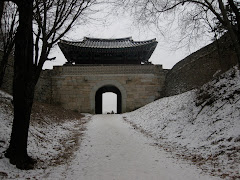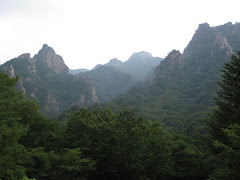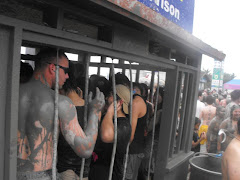It's been a busy couple weeks here in Korea, to say the least. Even though I haven't started packing yet, I have been super busy fulfilling many of the things I have wanted to do prior to leaving the country. This and the weather has finally started to be more spring-like with warmer temperatures during the day and chilly nights, which does wonders for one's spirits.
My April class schedule is also very accommodating. I teach four classes on Monday and Wednesday, but only two classes Tuesday and Thursday. This means I finish teaching at 10:30 a.m. Awesome.
My students remain great. Many of the students who have been with me for several months will end the month with me, and some have met me outside class to celebrate my impending departure. What a way to finish the year.
I have managed to sell some of my belongings, namely my guitar, computer speakers, two chairs from my apartment, and the plastic storage containers I originally purchased for clothes storage. I still have two bookcases, a coat tree, shoe rack, leather couch, and rug for sale should anyone reading this be interested.
My stitches were removed last Monday and my finger continues to heal nicely, though a small scar is noticeable on my fingertip. The stitches came out easier than they went in, and this time I managed to avoid passing out.
Temple Visit:
Gemma and I visited Bo Mun Sa in Seoul. We met with a female monk who served traditional Korean tea in ceremonial tea serving and discussed with us the intricacies of Buddhism. Tea is one of Buddha's six original offerings (tea, scent, flowers, lanterns, fruit, rice) and it is to be imbibed with all five senses: 1) hear the sound of the boiling tea water, 2) see the light's reflection in the tea vessel, 3) feel the warmth of the tea, 4) smell its scent, and 5) finally, taste the tea.
Bo Mun Sa has a rich history; located in Seoul and dating back to 1115 A.D., its the high temple of the Bomun order of Korean Buddhism, the world's only order of Buddhist nuns. Inside the temple grounds are two notable relics. The first is a large stone statue of the Buddha enshrined in a stone and glass cavern. The second is a nine story pagoda with divine significance; relics of the Buddha's teeth and bones are said to reside here.
Our friend the monk was most generous with her time, meeting with us for nearly three hours and leading us on a guided tour of the temple grounds. My favorite part of the experience, however, was the detailed lesson she provided me concerning tea service and preparation, and allowing me to sit in her seat following the tea ceremony. Apparently, this is a rare honor and is not a common occurrence when visiting a temple.
First Baseball Experience:
I finally made it to a Korean baseball game. It was great fun. On April 10, the Doosan Bears played the LG Twins. After six and a half innings, the Bears captured the lead and maintained this to win 3-2. Our seats were fantastic; they were furnished by my good friend, Mr. Gu, who works for Doosan Engineering and has access to the company's best seats. We were three rows behind home plate in an exclusive seating area so we could share picnic style lunch dinner and numerous rounds of beer and soju. Wow!
Unlike American baseball games, there are only eight teams in the Korean Baseball Organization. Most teams have their own stadium, except for Doosan and LG who share Jamsil Stadium. This is part of the greater Olympic Sports Complex, a large athletic park and leftover relic from the 1988 Seoul games. The stadium is smaller than most modern day U.S. stadiums, but the seating is close to the playing field so it has an intimate feel. Because the stadium is shared by two rival teams, the LG fans were seated along the third baseline and the Bears fans occupied the first base side.
Like all baseball games, draft beer was served by a rotating beer man, and lots of cheering was evident. "The wave" was also seen at times, as were the popular thunder sticks. Sadly, the seventh-inning stretch was missing along with the traditional singing of "Take Me Out To The Ballgame". Korean baseball fans have no idea what they're missing out on.
Best part of the experience were the Doosan cheerleaders, who apparently are famous throughout Korea for their good looks and sexy attire. Yes, they were entertaining to watch between innings, and it is worth mentioning that cheerleaders should have a place in baseball. Even the traditional "batboys" were staffed by cute females.
Final Korean Trip:
Gemma and I traveled to the Southern coastal areas of NamHae and Goeje Do for what was my final Korean trip. Some may say save the best for last, and this may be true. Everything was spectacular. In particular, the cherry blossoms were at their peak blossom and it added spectacular color to the entire weekend. We departed Sanbon at 11am Thursday morning and retuned home Sunday night around 10pm; approximately 83 hours and 1,200 kilometers later. Here is our story.
Our first destination was Namhae. Namhae is one of four principle islands located along the Southern coast of South Korea. We arrived just in time to secure a pension in the sleepy little village of Hongyeon, located along a beautiful bay. My favorite part of Namhae was the mountain coastal road, local road 1024, between Honghyeon-ri and Seongu-ri. It's the kind of hair-raising road with many blind corners, where one wrong turn or a careless mistake can lead to almost certain death as you careen over the edge of the road. Yes, it's dangerous, but oh so beautiful.
Thursday morning we left Namhae for Goeje Do. Along the way we stopped at Boriam Temple, located atop beautiful Geum Mountain. This mountain towers over NamHae at 681 meters, and affords commanding views of the South Sea and nearly all of the Southern coastline. It is because of this strategic location, that a smoke signal station was constructed back in 1150 A.D. and served as the Southern-most beacon to warn the Korean army of Japanese pirate attacks. According to historical information, one bright or smoky fire was lit in times of peace, two when the enemy was seen on sea, three when the enemy approached the shore, four when the enemy engaged in sea battle, and five when the enemy landed on the shore.
The trip to the top of the mountain takes about two hours on foot from the base, or you can follow the super-steep, transmission-burning, one and a half lane road to the parking lot located just one kilometer from the temple at the summit. This was our chosen route. Boriam Temple is one of the most famous ancient Buddhist temples in Korea. It was originally constructed in 683 A.D. and is said to enshrine relics of Buddha originally brought over from India. There is a three story stone pagoda which, apparently, was built using geomantic principles believed to ward off bad energy.
Between NamHae and Goeje lies the city of Tongyeong, formerly known as Chungmu. It connects with Goeje Do via a long bridge. This area boasts over 150 islands, and apparently, is regarded as one of the most beautiful ports in Korea. Besides being a centuries-old naval command post and the site of numerous naval conflicts, the area is famous for Chungmu Kimbap, a local variation of Kimbap served with marinated squid and pickled radish. Delicious! It is also here that the famous Korean turtle ship is said to have originated back in the 14th Century.
Goeje Do is the second largest island in Korea behind Jeju Do and is located in the South Sea relatively close to Busan. Goeje island is approximately 383 square kilometers and features several mountain peaks and natural harbors. It's biggest feature is Hallyeohaesang National Park, one of four marine-based national parks in Korea, and it extends along 120 kilometers of pristine shoreline. The scenery is absolutely gorgeous and parts of it reminded me very much of Hawaii with its steep mountain peaks surrounded by blue blue ocean. The subtropical climate complete with palm trees help reinforce this comparison, and the views from our pension in the seaside village of Gujora were spectacular.
Fishing is the centuries old industry on the island, however, its modern day industrial base is shipbuilding. In particular, Goeje is home to the vast shipyards of Samsung Heavy Industries and Daewoo Heavy Industries. Both companies not only fuel the local economy with 14 trillion Won of business each year ($11 billion), but also employ thousands of workers. These workers live in company built housing, which have become cities in themselves. It's amazing to see just how large these shipyards and their surrounding communities are.
Because of this, it is also understandable why there is currently a second bridge and new highway system under construction linking Goeje to Busan, the country's second largest city. When completed later this year, this Busan-Goeje Fixed Link will reduce congestion and travel time from more than three hours to about 40 minutes. Total cost of the project is estimated in excess of 2 trillion Won ($1.8 billion).
Perhaps my favorite part of the journey was OeDo Botannical Gardens. OeDo (pronounced "Way Doe") is a private island located off the Eastern shores of Goeje Do. The owners, a couple who have cared for the property since 1969, maintain pristine gardens filled with more than 3,000 rare and sub-tropical plants. It's a 15 minute boat ride from Goeje Do and the cost of admission is around 8,000 Won plus the 16,000 Won ferry boat ride. Originally, I had not planned on visiting here, but several of my students convinced me otherwise. I'm so thankful they did.
Four days in the car is a lot of driving. It's roughly five hours travel time from Sanbon to the Southern coast and Namhae, which we completed Thursday afternoon. Friday's drive was around four hours plus many stops, including Boriam Temple, GeumSan, and Tongyeong, all of which are located between Namhae and Goeje. Saturday was spent circumnavigating the entire island of Goeje, including the two and a half hours associated with OeDo. I suppose the entire island of Goeje can be driven in two to three hours, but this schedule does not permit stopping for photos, lunch, etc. These frequent stops can extend the travel time by three or more hours.
Total cost of the 4 day trip was around 700,000 Won as follows:
Gas - 200,000 Won (100,000 Won x2 fill-ups)
Highway Tolls - 30,000 Won
3 nights Lodging - 200,000 Won
Groceries (we cooked dinner two nights) - 100,000 Won
Restaurants - 100,000 Won
Sightseeing Expenses - 70,000 Won
After reviewing these figures, and comparing this to other trips I have taken in Korea, I can definitely say it is far more economical to travel via train or bus. Unfortunately, gas is expensive in Korea as are highway tolls. Depending on your destination, this will often leave you stranded in rural areas without the ability to see the many out-of-the-way sights. But any experienced traveler will agree, these are often the best parts of a journey. So there is a price for freedom and flexibility.
Conclusion: if you want to see rural Korea, travel with friends. Share the expense. Fill the car (and the trunk) with as many people as possible. Otherwise, stay on the main roads and take the more economical bus or train.
With less than two weeks remaining, that's about all I have to report. The final days will be busy packing, selling my remaining furniture and apartment furnishings, and saying goodbye to friends. It's bittersweet, to say the least, and of course my sadness associated with leaving Korea is replaced by the joys of returning home.

























































































































































1 comment:
I will have to return to this and read it more in depth and study the pics when I have more time. Read the latest on MTW on Caring Bridge.
Let us know your schedule when you return to the states. Can't wait to see you - both of you!
Love,
Beth
Post a Comment